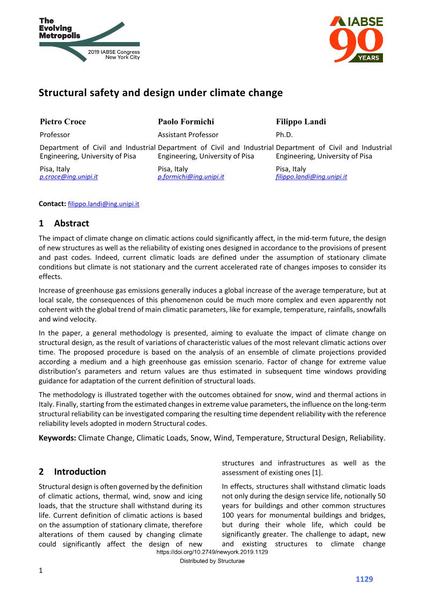Structural safety and design under climate change

|
|
|||||||||||
Détails bibliographiques
| Auteur(s): |
Pietro Croce
Paolo Formichi (Department of Civil and Industrial Engineering, University of Pisa) Filippo Landi (Department of Civil and Industrial Engineering, University of Pisa) |
||||
|---|---|---|---|---|---|
| Médium: | papier de conférence | ||||
| Langue(s): | anglais | ||||
| Conférence: | IABSE Congress: The Evolving Metropolis, New York, NY, USA, 4-6 September 2019 | ||||
| Publié dans: | The Evolving Metropolis | ||||
|
|||||
| Page(s): | 1129-1134 | ||||
| Nombre total de pages (du PDF): | 6 | ||||
| DOI: | 10.2749/newyork.2019.1129 | ||||
| Abstrait: |
The impact of climate change on climatic actions could significantly affect, in the mid-term future, the design of new structures as well as the reliability of existing ones designed in accordance to the provisions of present and past codes. Indeed, current climatic loads are defined under the assumption of stationary climate conditions but climate is not stationary and the current accelerated rate of changes imposes to consider its effects. Increase of greenhouse gas emissions generally induces a global increase of the average temperature, but at local scale, the consequences of this phenomenon could be much more complex and even apparently not coherent with the global trend of main climatic parameters, like for example, temperature, rainfalls, snowfalls and wind velocity. In the paper, a general methodology is presented, aiming to evaluate the impact of climate change on structural design, as the result of variations of characteristic values of the most relevant climatic actions over time. The proposed procedure is based on the analysis of an ensemble of climate projections provided according a medium and a high greenhouse gas emission scenario. Factor of change for extreme value distribution’s parameters and return values are thus estimated in subsequent time windows providing guidance for adaptation of the current definition of structural loads. The methodology is illustrated together with the outcomes obtained for snow, wind and thermal actions in Italy. Finally, starting from the estimated changes in extreme value parameters, the influence on the long-term structural reliability can be investigated comparing the resulting time dependent reliability with the reference reliability levels adopted in modern Structural codes. |
||||
| Mots-clé: |
vent
|
||||
